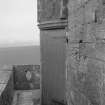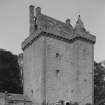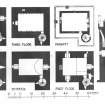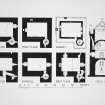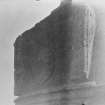Pricing Change
New pricing for orders of material from this site will come into place shortly. Charges for supply of digital images, digitisation on demand, prints and licensing will be altered.
Field Visit
Date 8 June 1925
Event ID 1098391
Category Recording
Type Field Visit
Permalink http://canmore.org.uk/event/1098391
Scotstarvit Tower.
Scotstarvit, though unoccupied, is in perfect preservation. It stands on high ground about three miles south of Cupar. Five storeys and a garret in height, the building is L-shaped on plan, with a main block 33 1/3 by 27 ¼ feet and a wing 6 feet 10 inches by 13 feet 2 inches, the latter containing a continuous newel-stair from ground to parapet. The masonry is of ashlar, laid in courses from 9 ½ to 15 inches in height. The only moulding employed at the voids is a chamfer. The walls rise unbroken to the parapet, which is borne on moulded corbels of two members and has a moulded cope returning round small merlons and wide embrasures; the angles of the parapets are furnished with 'gunholes'. Within the parapet of the wing rises a cap-house, which is surmounted by a little conical stone spire furnished with lucarnes. The door at the stair-head, giving access to the parapet-walk, is surmounted by an armorial panel, containing a shield parted per pale: dexter, on a bend a mullet between two crescents, for Scott; sinister, three bars wavy, for Drummond. The shield is flanked by the initials S.I.S., for Sir John Scot, and D.A.D. for Dame Anne Drummond, his first wife, sister of Sir William Drummond the poet, while their initials I.S. and A.D. are repeated below. At the bottom of the panel is the date 1627, and this date appears again, in much later figures, on the upper face of the moulded margin. The position of the panel is unusual, and it seems to be a later insertion. The main roof rises from the parapet-walk and is covered with stone slates; the gables are crow-stepped. The chimneys are slender, which accounts for the unusual double stalk on the western side.
Within the re-entrant angle, which opens to the south-west, lies the entrance, a doorway with a semi-circular roll-moulded head. Here a little mural lobby gives access to the stair foot and to the lowest storey. The latter runs the full extent of the main block and has a narrow window in each gable; on its side-walls are corbels for the flooring of the entresol. This upper storey, which is entered from the stair and is the same size as the lower chamber, has also windows in the gables but they are larger than those below and are provided with seats in the embrasures; the ceiling is an ashlar barrel-vault. The first and principal floor seems to have been divided unequally into two unvaulted apartments, probably 'screens' and Hall. The inner part or Hall has windows looking north and south and having seats, and it had a fireplace in the gable, which was subsequently reduced in size and latterly built up entirely. In the outer chamber a window, also with seats, looks east, and there is a garderobe at the north-east corner, and a sink beside the entrance. At the same level is a small mural chamber entered off the staircase, and having a lamp recess and a window. The second floor is a single, vaulted chamber having windows with seats to east and south and a built-up fireplace in the north wall. The third floor is a poor room, lit only from the lower part of windows, the sills of which are at the level of the parapet-walk. There is a fireplace in the west gable, and on the side walls are corbels to support the flooring of the garret which seems to have been by way of contrast a pleasant chamber, adequately lighted and formerly containing an ornate fireplace, now removed to the present proprietor's mansion of Hill of Tarvit. Its lintel bears the arms and initials of Sir John Scot and Dame Anne Drummond with the motto, SPE EXPECTO, and on the pediment are their monogram and the date 1627. It is quite exceptional to find so elaborate a fireplace in a garret chamber, and it may be assumed that in this case the garret was the laird's private room or study, for which purpose it was not ill-suited, being removed from the household and having a pleasant outlook on all sides.
There is no room within the tower which can be identified as the kitchen; it may have been in an outbuilding, of which slight traces remain on the west. The well lies about 50 yards south of the house.
CARVED STONES. There are two carved stones in the interior. One, which is understood to have been removed from Wemyss Hall, now Hill of Tarvit, is dated 1723 and bears the inscription, A WIGHT MAN NEVER WANTED A WAPON W.E. (William Balfour); below is a shield bearing: A chevron between three tadpoles, a crescent and star for difference. The arms are those of Russell, David Balfour of Kinloch having married the heiress of Russell of Bankton and Kingskettle, while William Balfour succeeded his brother David.
The second stone is a very elaborately carved circular vaulting - boss of early 16th-century date, 2 ¼ feet in diameter. The border is a garland and encloses a crowned shield bearing the Royal Arms; the lion faces sinister.
HISTORICAL NOTE. - Sir John Scot purchased ‘Tarvett’ from Alexander Inglis in1611 (1), and in 1612 his lands in Fife were incorporated as the barony of Scotstarvit (2). Sir John was Director of the Chancery and the author of The Staggering State of the Scots Statesmen, &c. Although there is no reference to any building in a charter of 1550 (3), a charter of 1579 mentions a tower as existing on the barony of Tarvet (4). The tower therefore may already have been in existence for more than thirty years before Sir John Scot acquired the lands. But if it does not refer to the building of the tower, there does not appear to be any particular reason for the date 1627 above the door leading to the parapet-walk, unless it be that certain alteration sand repairs - e.g. the insertion of the ornate fireplace with the same date - were carried out in that year.
RCAHMS 1933, visited 8 June 1925.
(1) Reg. Mag. Sig., s.a., No. 588. (2) Ibid., No. 747. (3) Ibid., s.a., No. 406. (4) Ibid., s.a., No. 2926. Cf. also Cast. and Dom. Arch., ii, p.40.










